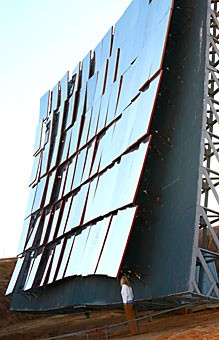Four years ago, UA alumni Richard and Monica Chapin were searching for a way to help a friend stricken with pancreatic cancer.
“”We used to talk about finding ways to help her,”” Richard Chapin said. “”And light therapy came up as a very big deal.””
Although their friend died before they could completeit, they embarked on a $2 million project, uncovering research indicating that light from the moon could have healing powers.
“”Moonlight is different from sunlight in that it has its own chemical makeup and spectrum,”” Chapin said. “”Using these parts of the spectrum may indeed help our bodies and immune system.””
After following research and a hunch regarding the importance of moonlight on health, the Chapins put their heads together with a team of experts whose backgrounds ranged from optical sciences to mechanical engineering.
Two years later, the result was a massive five-story-high by 60-foot-long moonlight collector, which lives in the darkness of the desert near Kitt Peak, where the greatest amount of moonlight can be reflected.
“”We worked long and hard on it and spent a lot of time and money to come up with the first of its kind,”” Chapin said. “”It collects more light than any telescope on earth, and this type of light can be projected at the size of a pinpoint laser or spread out to a 10 or 15 foot area.””
Each night, the interstellar light application reflects the light projected from the moon. When aimed towards humans, Chapin said, the effects on health are awe-inspiring.
“”We have had over 250 people that have been through it now at different exposures,”” Chapin said. “”Their stories are amazing, from pain alleviation to helping with depression. Something about the moonlight leaves people feeling great.””
Of course, not all of the results have been this spectacular. Each exposed group consists of about 30 at a time, and often there are two or three people who say that they feel close to nothing after exposure to the celestial light, Chapin said.
“”We are still trying to understand the time periods of exposure,”” Chapin said. “”There were some people who said, ‘Thank you, but I didn’t feel anything.'””
But for the participants who did experience changes, Chapin added, the effects of moonlight exposure have led to weight loss of almost 100 pounds in one case, and the temporary disappearance of pre-cancerous cells after an exposure of only two minutes in another case.
Sage Mendola, a cognitive science junior who works reconfiguring the mirrors of the panel so they reflect the greatest amount of moonlight, said that he has experienced the effects of the light projector firsthand.
“”It’s really interesting because it’s incredibly bright, but you don’t need to squint,”” Mendola said. Although he has not experienced the light in regards to his own physical health, Mendola said participants often rave about the treatment after exposure.
“”It’s a really unique experience,”” Mendola said. “”In one of the most obscure experiments, a group of people began humming after.””
Chapin said since very few people are aware of the potent effect moonlight can have, he is interested in pursuing an intensification of his research.
“”Based on this research, which is the first of its kind, why not increase a great thing?”” Chapin said.
Increase, they will. After encouraging research on moonlight and its effects on humans, Chapin and UA researcher Corrine Davies, who was out of town and unavailable for comment, have started to experiment with moonlight and its effects on plants.
“”In plant research, the genome sequence is also associated with that of humans,”” Chapin said. “”It’s amazing what the moon does. It controls everything from wheat and tomato growth to hamster hormone production.””
Right now, researchers associated with the project are few in number, but Chapin said he would like to expand it to include interested researchers from the UA and other universities.
“”We have found that the light truly affects us,”” Chapin said, “”We are all just little creatures on a big world, but this goes to show that each one can make a big difference.””









